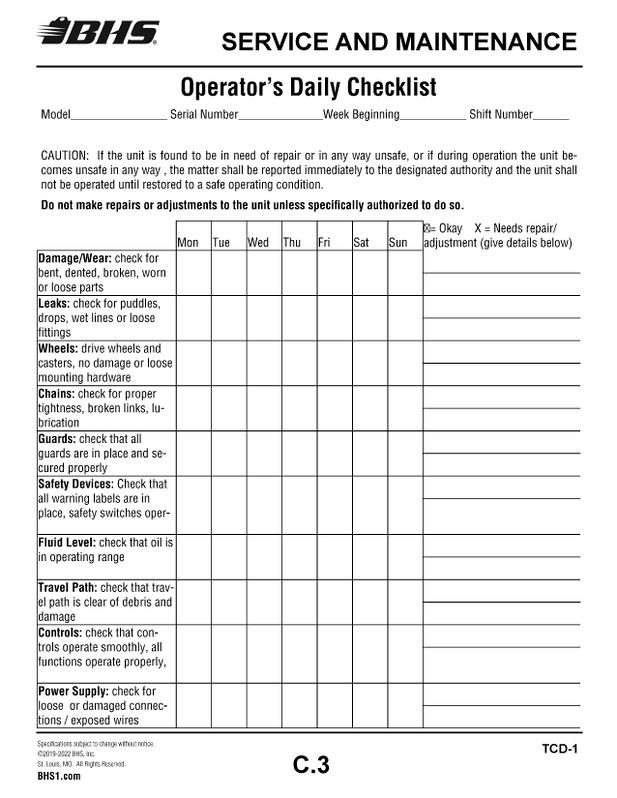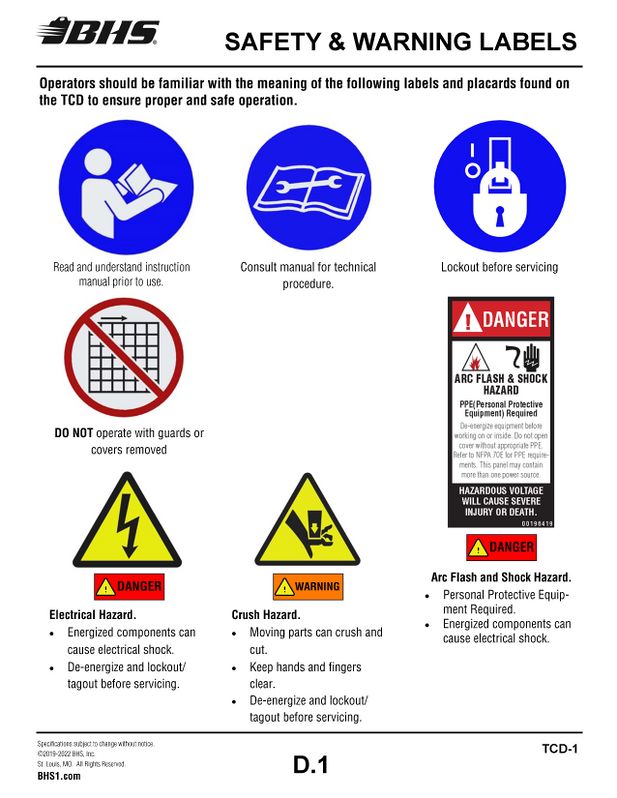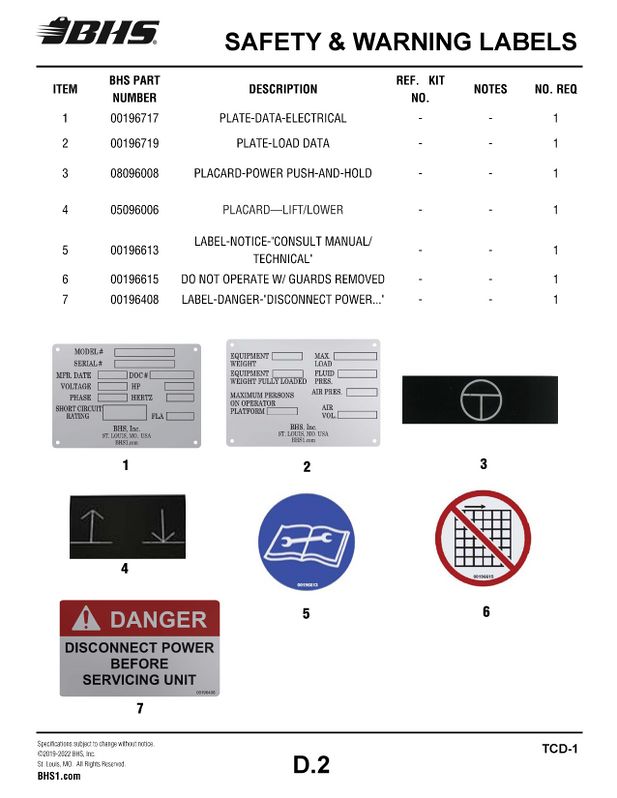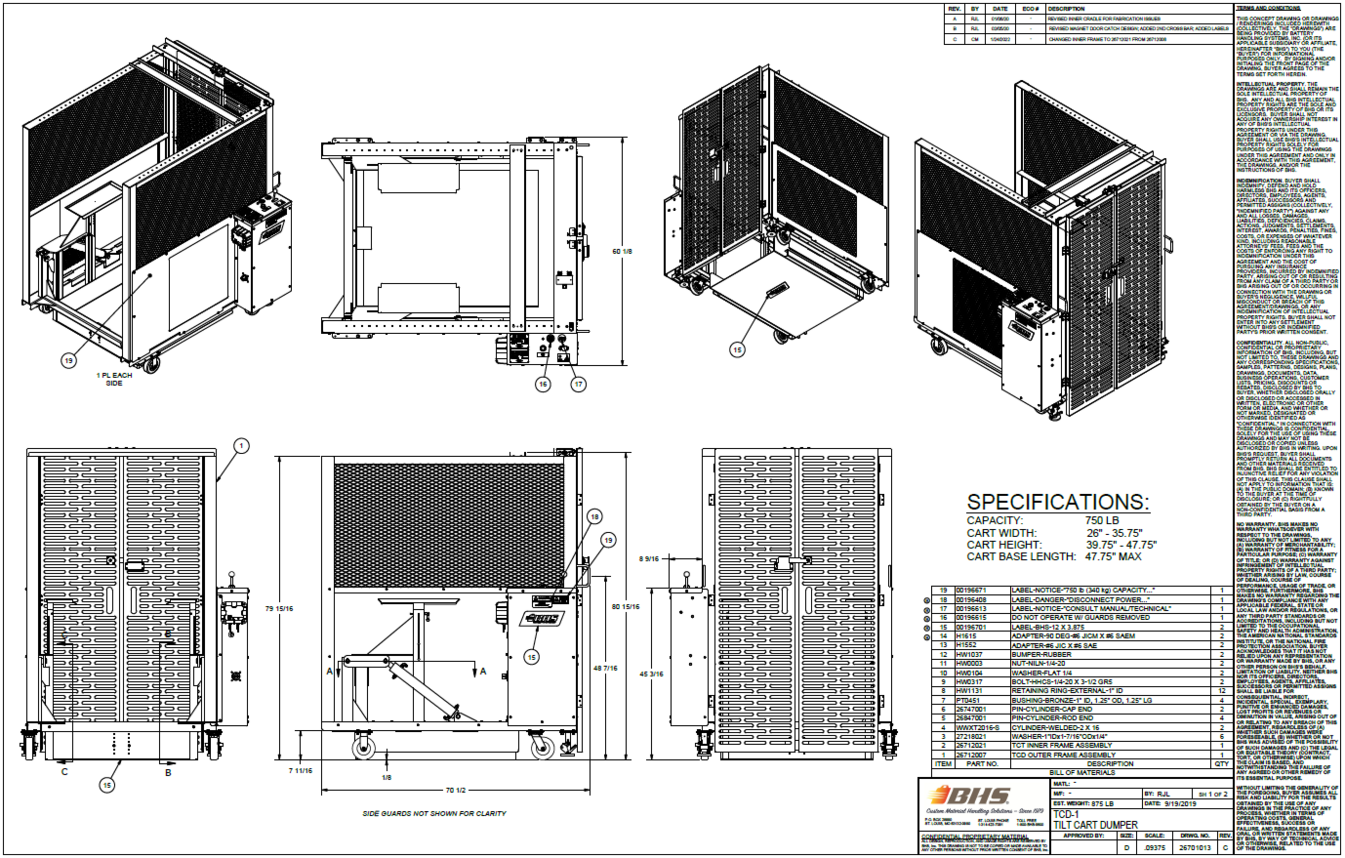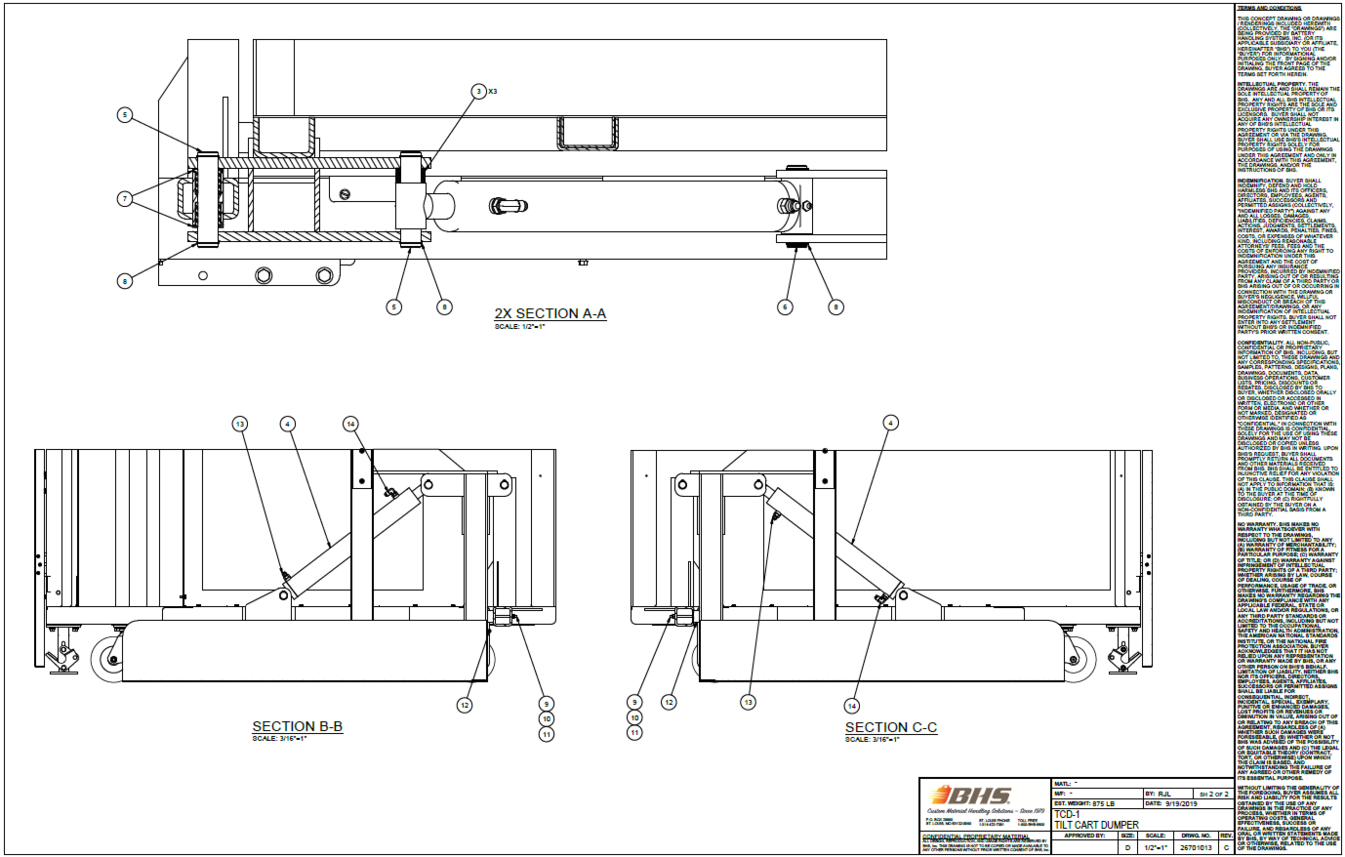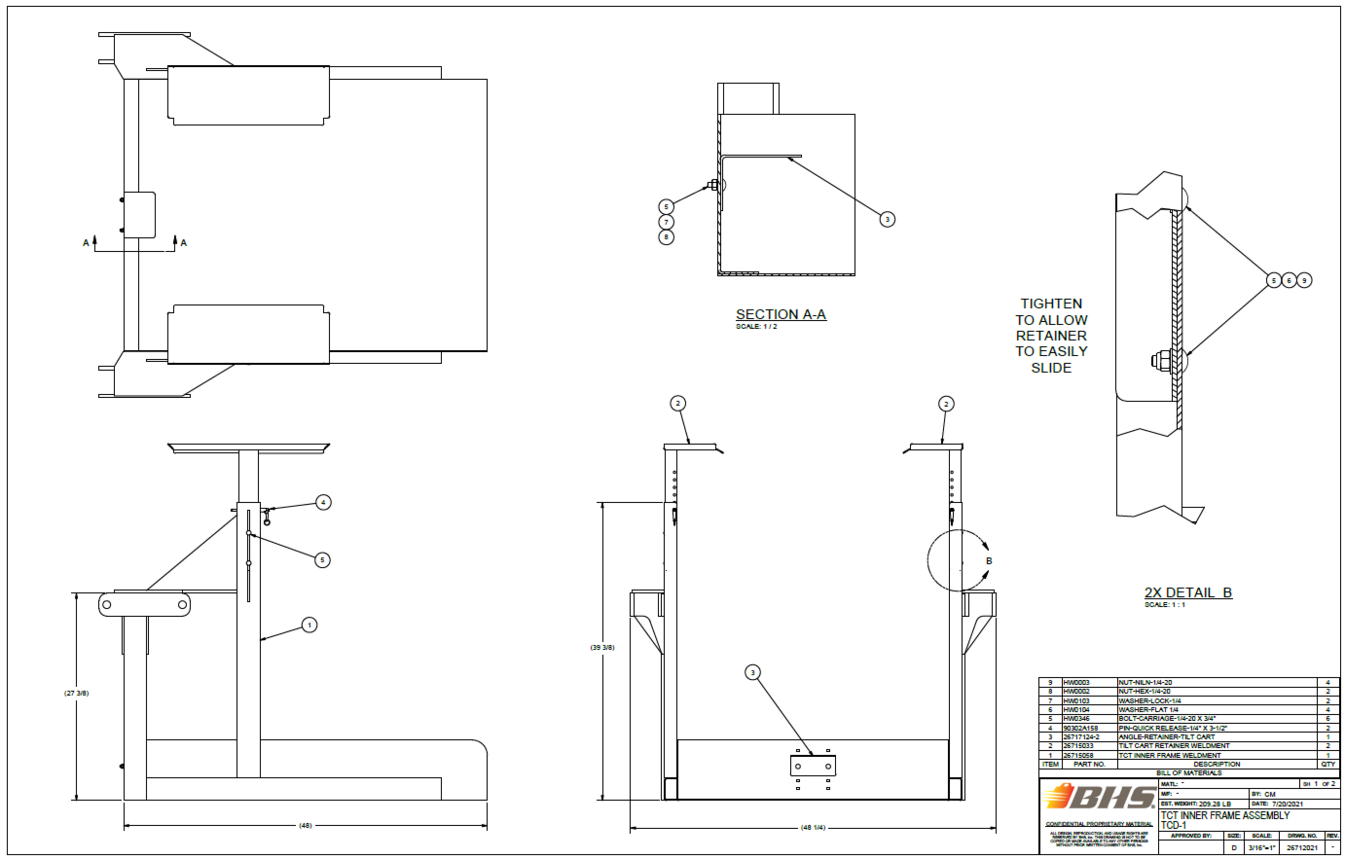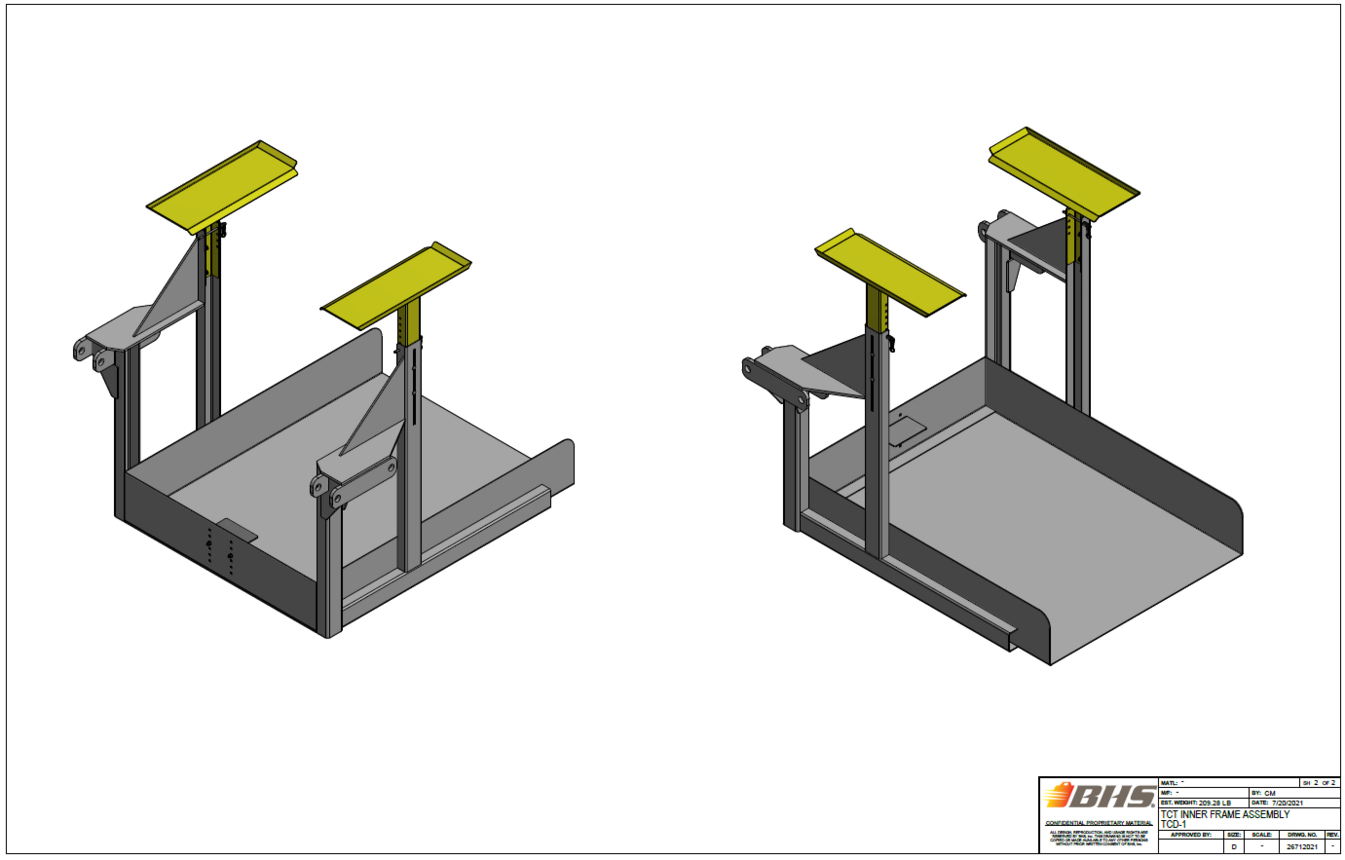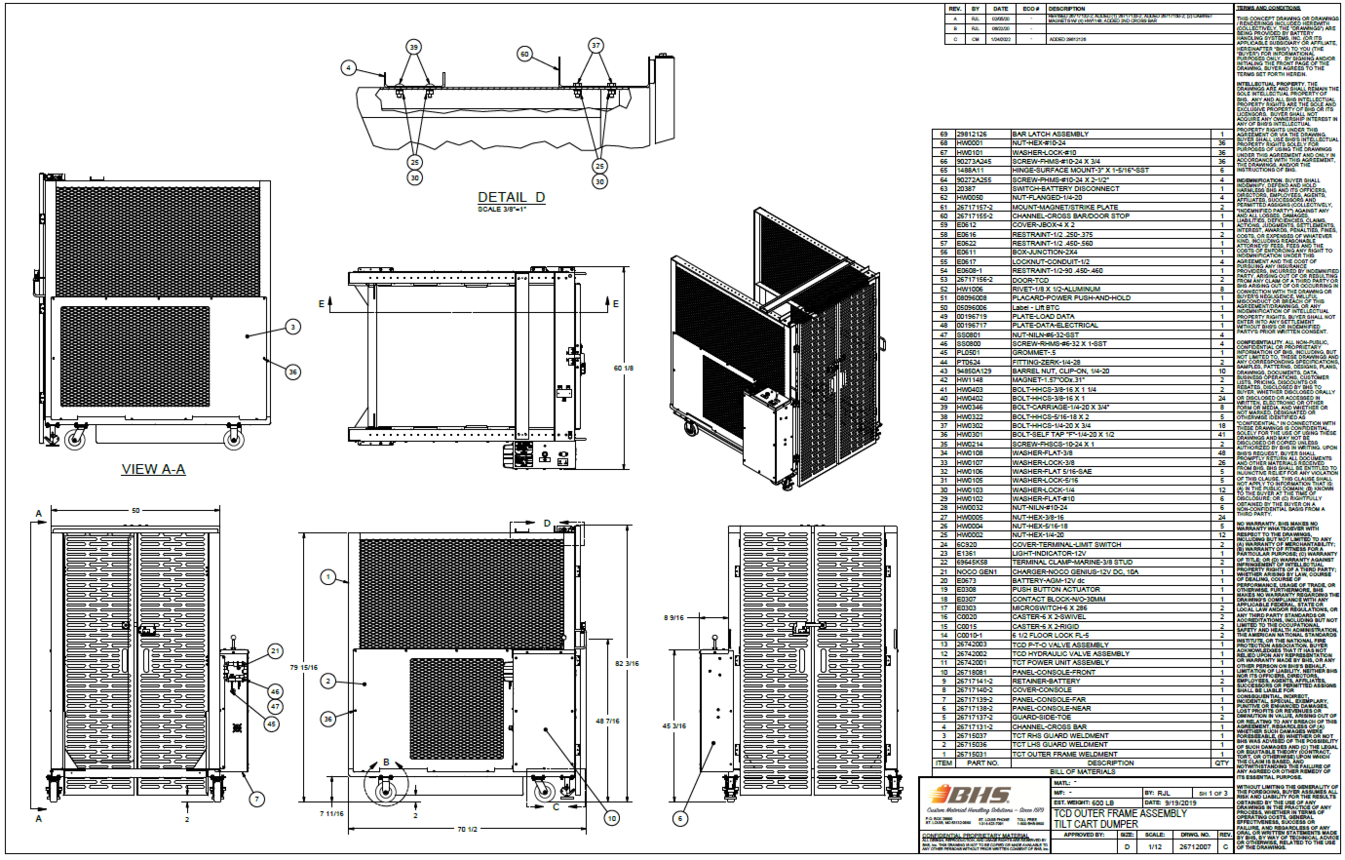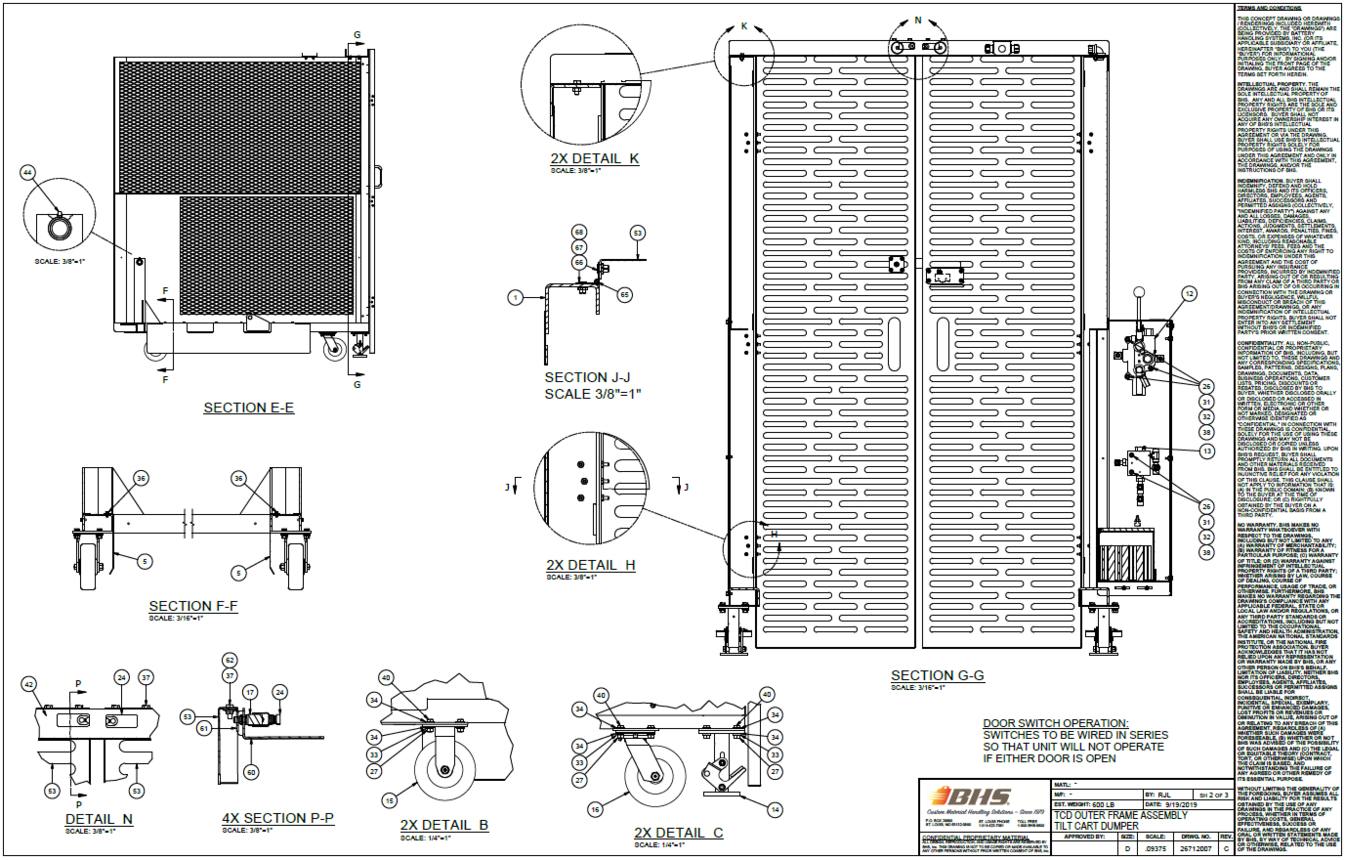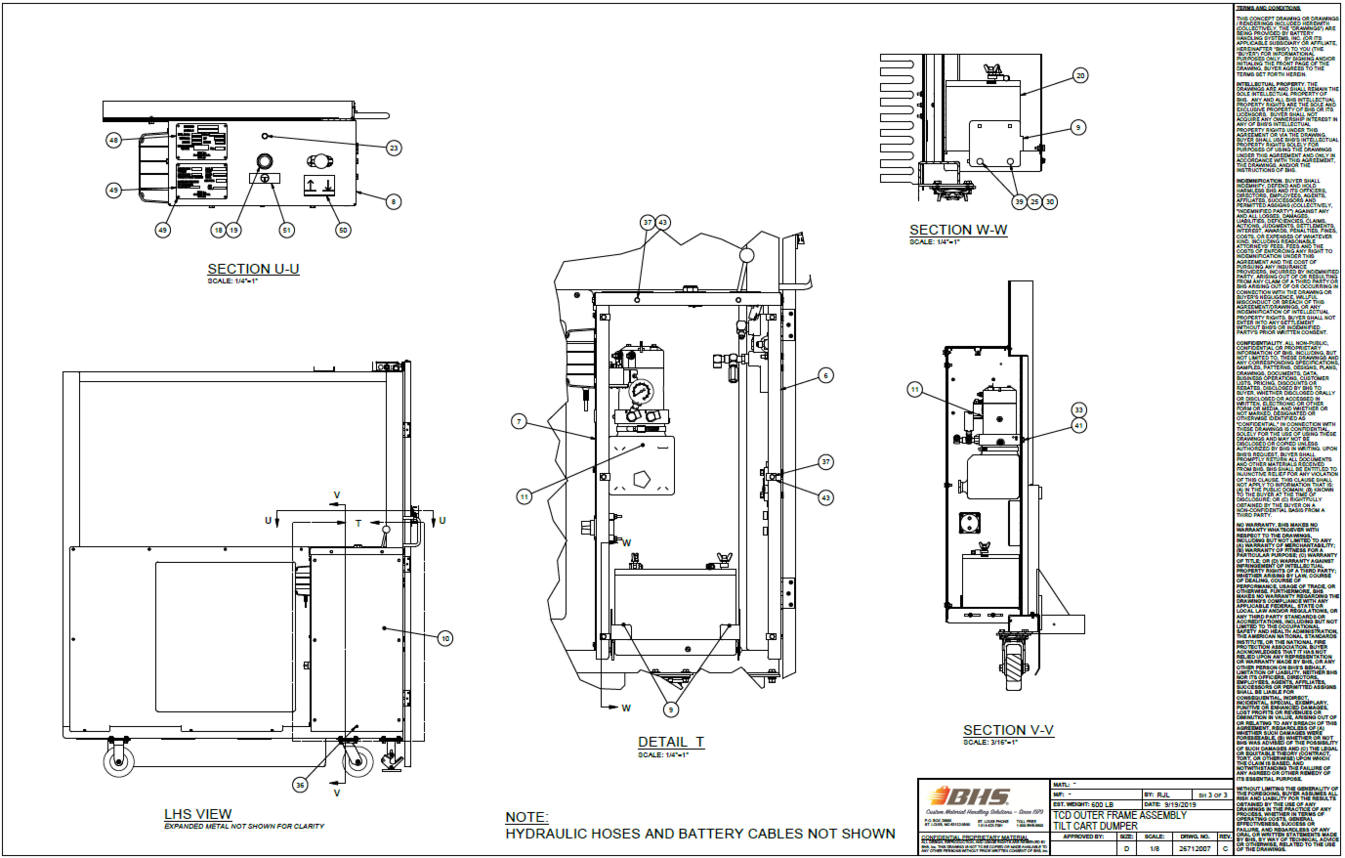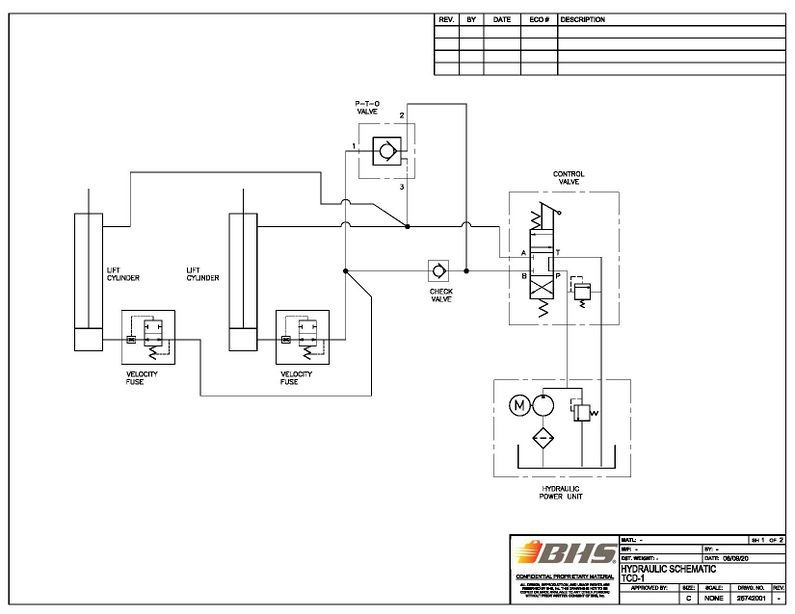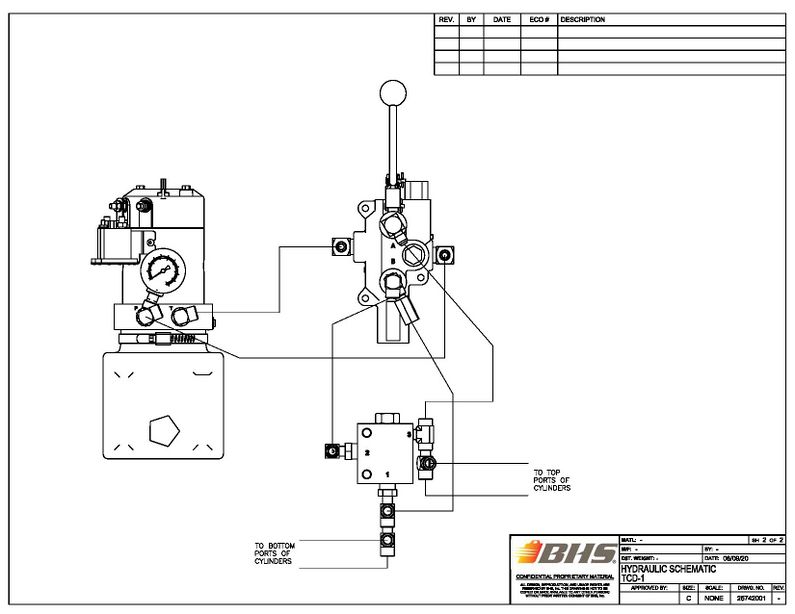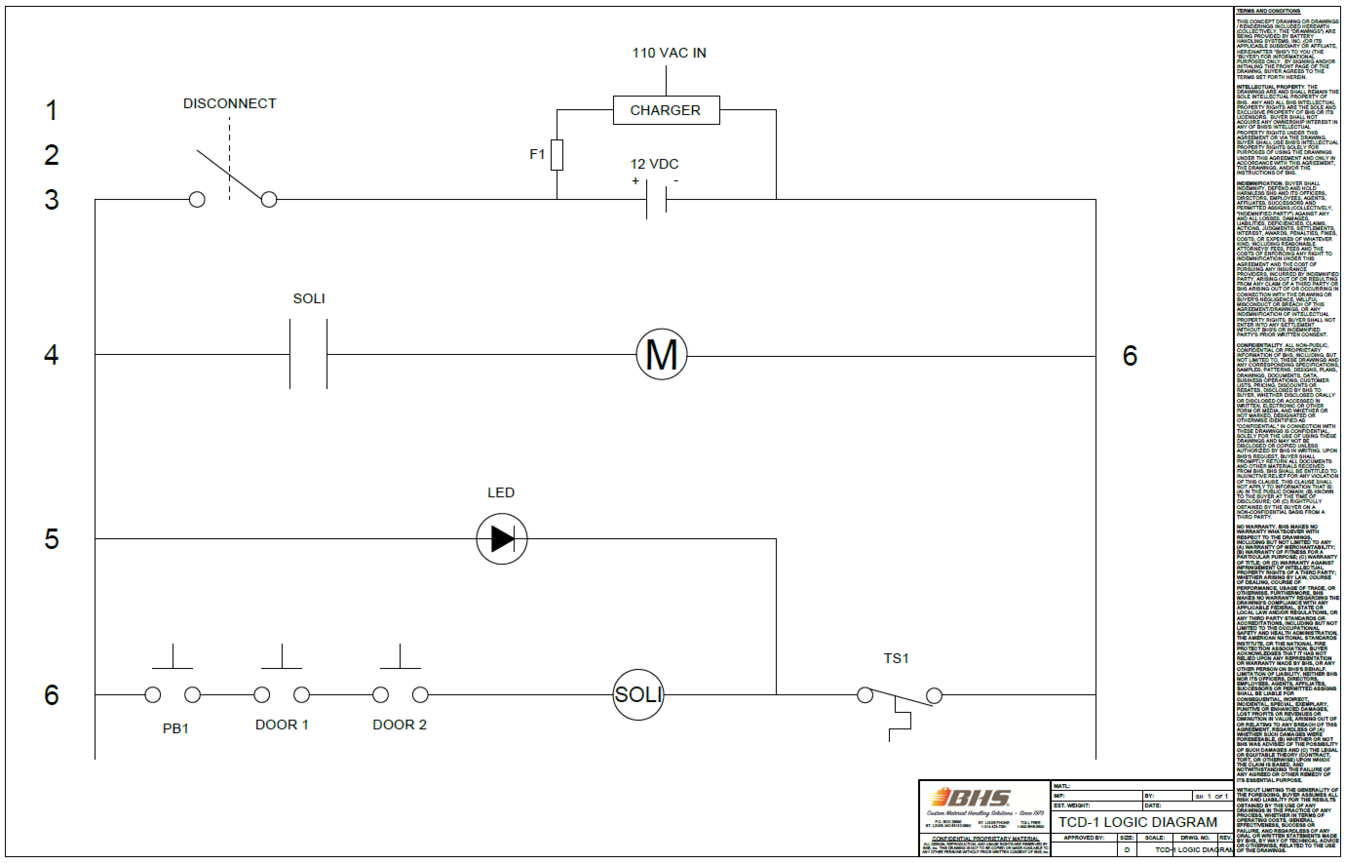IOP-TCD-1 Manual
Looking for a specific replacement part? Ctrl-F (or Command-F for Mac users) brings up your browsers search panel and can search any text on the entire web page. Find parts by searching a part # or part description.
Register your equipment with BHS Optima, BHS's free app.
California Residents: WARNING: This product contains chemicals known to the State of California to cause cancer and/or reproductive harm, and birth defects or other reproductive harm. Learn more here.
Tilt Cart Dumper (TCD) Parts & Services Manual
GENERAL INFORMATION
Read and understand this manual before installation, use, and maintenance for your unit. Please be sure that no individual is allowed to use this unit unless they have been fully trained and familiarized with the operating instructions of this manual. Also, ensure that at least one person on site is familiar with the maintenance section of this manual and is responsible for performing the defined tasks. If you have any questions regarding operation, service, or the contents of this manual, please contact your dealer or BHS Technical Support 1.877.BHS.4YOU (1.877.247.4968) or visit tech.bhs1.com.
Tilt Cart Dumper (TCD Series) improve ergonomics and productivity. The TCD Series is designed to reduce physical strain, fatigue, and prevent injury by eliminating heavy lifting, bending, and reaching. Tilt Cart Dumpers are available in many standard sizes and capacities to lift and position loads. Please consult a dealer or sales representative for application specific needs.
GENERAL SAFETY
- Read and understand all instructions and warnings before using or servicing this equipment.
- Keep these instructions for future reference.
- Units shall only be used indoors in an industrial setting on a hard, nonslip, and level floor without irregularities including but not limited to holes, gouges, cracks, drains or obstacle comprised of concrete or other suitable industrial material.
- Forces required to operate the unit vary with weight of the load, floor conditions, and unit conditions.
- Perform system and safety checks before operating.
- Failure to follow these instructions and warnings may result in property damage, personal injury or death.
WORK AREA
- Keep work area clean and well lit. Cluttered work areas and poor lighting can lead to accidents.
- Clean up/contain any fluid spills immediately to prevent slips or falls.
- Be aware of potential hazards when performing any service or maintenance to the unit.
SERVICE & MAINTENANCE
Service personnel shall wear Personal Protective Equipment (PPE) appropriate for the task being performed.
LOCKOUT/TAGOUT
Lockout/tagout the unit if damaged or not functioning properly. Lockout/tagout and de-energize all systems prior to performing any maintenance or service to unit(s).
LEAD-ACID BATTERIES - EXPLOSION HAZARD (NOTE: IF APPLICABLE)
- Do not allow open flames or sparks of any kind near a battery. Highly explosive gas is generated when charging a battery that can remain in battery cells for extended periods of time after charging is complete.
- Do not place metal or other conductive objects on top of battery. Arcing may occur causing damage to the battery and/or serious personal injury or death.
- Use only chargers matching the voltage and amperage of the battery being charged. Overcharging a battery can cause damage to the battery, charger and/or serious personal injury or death.
- Turn off charger before disconnecting battery from charger. Arcing between battery and charger connectors can cause damage to the connectors and/or serious personal injury or death.
HYDRAULIC HAZARDS
PRESSURE FLUIDS - Escaping fluid under pressure can penetrate the skin causing serious injury. Relieve pressure before disconnecting hydraulic lines. Tighten all connections before applying pressure. Keep hands and body away from pin holes which eject fluids under high pressure. Use a piece of cardboard or paper to search for leaks. DO NOT use your hand.
Any fluid injected into the skin under high pressure should be considered a serious medical emergency despite an initial normal appearance of the skin. There will be a delayed onset of pain, and serious tissue damage may occur. Medical attention should be sought immediately.
OPERATIONAL SAFETY
- Only personnel trained in the proper and safe operation of the units may operate or service the TCD.
- All data plates, warning labels, placards, etc shall be in place and legible at all times. Contact BHS for replacement data plates, warning labels, placards or instructions.
- All users and service personnel shall be familiar with the meaning, significance, and risks associated with all data plates, warning labels, etc.
- All operators and service personnel shall be aware of potential crush and shear points while operating or servicing the unit.
- Units shall be operated in an area with ambient light levels of at least 50 lux.
- Keep hands, arms, feet, legs, hair, and jewelry out of the travel path while operating the unit.
- Avoid abrupt changes in elevation when operating a unit to prevent loss of the load and/or loss of control of the unit.
- Remove the unit from service if damaged or operating improperly (or becomes such while operating) until repairs can be made to correct any problem(s).
DO'S AND DONT'S
- DO NOT exceed the maximum capacity of the unit.
- DO NOT modify or fit the unit with attachments without prior, written approval from BHS.
- DO NOT perform any maintenance or service to the unit with a load in the carriage.
- DO NOT attempt to move the unit with a load in the carriage.
- The inner carriage must be slightly raised before the unit can be moved.
- DO NOT allow anyone to ride in or climb on the unit .
- DO NOT operate the unit with any electric or hydraulic guard or cover removed unless required for maintenance or repair.
- Disconnect the unit from all power sources before attempting to perform service or maintenance to the unit.
- Engage floor locks before lifting any load
- DO NOT use the unit in a manner for which it is not intended. Some examples of prohibited use are but not limited to:
- As a vehicle jack
- To lift loads greater than its rated load capacity
- Where unintentional movement may occur
- Having direct contact with foodstuffs
- In a potentially explosive atmosphere
- On an uneven floor or surface
- Without being properly anchored to the floor (Note: Stationary Models only)
OPERATING INSTRUCTIONS
The following instructions will guide you through the basic steps necessary to properly and safely operate this unit. Before using this unit, the operator should:
- Read and understand this manual and the operating instructions.
- Be thoroughly trained on the use and safety of this unit.
- Inspect for proper operating conditions and safety devices.
- Check for and eliminate any obstructions in the travel path.
- Inspect all hydraulic connections to ensure they are complete and operational.
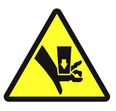
KEEP HANDS, ARMS, FEET, LEGS, HAIR, AND JEWELRY OUT OF THE TRAVEL PATH WHILE THE UNIT IS OPERATING
LOADING THE PLATFORM
The load capacity rating is noted by the model number stamped in the model/serial tag located on the control panel. The capacity rating is the maximum load for a standard TCD model with a standard inner frame. Modifications and additions to this unit shall not be made without prior written consent from the manufacturer. Where special attachments are installed on the unit after shipment, deduct the weight of these from the load capacity rating to obtain the new maximum capacity.
- NEVER EXCEED THE LOAD CAPACITY RATING. Overloading the unit will result in severe personal injury or death, cause structural damage to the unit, shorten the life of the unit, and void the unit’s warranty.
- ALWAYS BALANCE & CENTER THE LOAD Balanced and centered loads will promote the longest life of the unit and ensure even wear on all moving parts.
- ALWAYS SECURE THE LOAD A balanced and secure load is the safest means of lifting the load.
- Lower the platform to the fully lowered position by holding the ⬇DOWN⬇ option.
- Transport the load to the TCD platform.
- Center, balance, stabilize, and secure the cart or receptacle. Secure the load using the retaining arms.
- With the load properly positioned and secured, close both doors and secure them with the door lock.
- To activate the TCD push and hold the activation switch to power the unit, move the control lever to the up position to dump the cart.
- Once the unit is fully rotated and cart is emptied, continue holding the activation switch and move the lever to the down position to return the unit to the lowered position.
- Carefully watch the platform as it raises to ensure proper function of all hydraulic components.
- Lockout/Tagout the unit and immediately notify your supervisor or maintenance personnel if the unit is found to be operating abnormally.
SERVICE AND MAINTENANCE
TCD MAINTENANCE
KEEP HANDS, ARMS, FEET, LEGS, HAIR, AND JEWELRY OUT OF THE TRAVEL PATH WHILE THE UNIT IS OPERATING.
Failure to follow proper safety procedures can result in serious personal injury or death.
Failure to properly support the inner frame when performing any service on the unit will result in serious personal injury or death.
Failure to disconnect electrical power to the unit could result in electrical shock. Serious personal injury or death will occur.
With the platform in the fully lowered position, cycle the ⬇DOWN⬇ control valve several times to relieve stored hydraulic pressure. See Figure 1.
Failure to release any stored hydraulic pressure could result in injury from:
- Escaping hydraulic fluid under high pressure (see HYDRAULIC HAZARDS in the GENERAL SAFETY section).
- Unexpected movement of hydraulic components.
- Disconnect the DC power supply. Lockout/Tagout the unit.
RECOMMENDED TILT CART DUMPER (TDC) LUBRICATION INTERVALS
| # OF PLACES | INTERVALS | |
|---|---|---|
| Lubricate grease fittings using #2 lithium based grease. | ||
| A. Lower Cylinder Clevis | 2 places | Monthly |
| B. Upper Cylinder Clevis | 2 places | Monthly |
| C. Upper Hinge Shafts | 2 places | Monthly |
| Complete Preventative Maintenance (PM) | - | Quarterly |
These recommendations are based on average use in a typical warehouse environment and may need adjustment based on individual circumstances. Dusty and/or extreme hot/cold environments may require more frequent lubrication.
* BHS recommends implementing an oil sampling and analysis program to monitor fluid condition and determine when hydraulic fluid change is required. The fluid analysis program should be a continuous process and all results should be evaluated. Changes in the condition of the hydraulic system may indicate component wear, fluid deterioration, and contamination.
RESERVIOR CAPACITIES (Approx.)
- HCO0O2-4 0.8 Gal (3.0 L)
The reservoir should be filled so the fluid level is within a half inch (1/2”) of the top of the reservoir, while the unit is in the fully lowered position. Use Chevron AW-32 or equivalent ISO 32 grade hydraulic oil.
Hydraulic fluid should not exceed 140°F (60°C) for extended periods.
- DO NOT clean this unit with a high pressure wash.
- Wipe the unit down with a clean, dry cloth when cleaning is required.
OPERATOR'S DAILY CHECKLIST
SAFETY & WARNING LABELS
PARTS SECTIONS
CHASSIS
HYDRAULIC
ELECTRICAL
STATEMENT OF WARRANTY
Statement of Warranty
Click here for details on BHS' Statement of Warranty.


